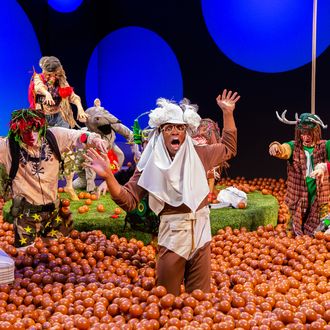
Everybody has a last show.
Mine was The Fre at the Flea. The Flea Theater stayed open just a few days longer than Broadway, so when my uptown show canceled, I switched my tickets for the downtown production, tamping my fears down to the point that I could almost ignore them. The Fre — a Taylor Mac fable about the costs of escaping a homophobic, anti-art background — took place in a ball pit. I look back at the emails I sent that day to the theater, in which I rather shrilly asked, “can I sit on a chair instead of in the pit?” and marvel that I thought I was somehow in control of my risk. I didn’t wear a mask; I remember trying to open the door to the bathroom without using my hands. I spent much of the show watching a member of the audience, an Obie Award winner for her lifelong support of the theater, delightedly reclining among the balls. Her gray head would occasionally disappear beneath the surface.
The conversations I’ve had around the anniversary have often been of the “little did I know” variety. Little did I know that night, for instance, that I’d go into Manhattan only three times in the next 365 days. Little did I know that I didn’t need to worry about the balls as much I needed to be avoiding the person sitting behind me. Then, come to think of it, the pandemic has been a period of getting a lot of “little did I know” stuff out into the open, including (but hardly limited to) the troubling ethics of the industry and the intense vulnerability of those who make a living in it. Take the Flea. Since The Fre, the venue has staggered under successive waves of crisis: shutdown, furloughs, a company-wide call for labor and racial justice, the departure of the longtime managing director (and main target of the grassroots reckoning), a fissure in the board, more layoffs (of unpaid folks this time), silence. I knew a bit about the troubles there before the shutdown, but really … little did I know.
Yesterday, the theater threw a little party for itself in Father Duffy Square — the north end of Times Square — where the big red TKTS steps look out over the hustle and bustle. For once, despite the shutdown, there was some bustle to see. We Will Be Back was a collaboration between the Times Square Alliance and Broadway Cares/Equity Fights AIDS; it was a USO-style event to rally the troops, send a hopeful signal for the neighborhood, and generally get people used to the idea that live, in-person entertainment was on its way back. It was a standard public event, with “once more unto the breach” speeches from playwrights and actors and arts boosters, interspersed with a few musical numbers.
As with many outdoor performances, the sight lines were impossible. Even standing in the VIP watching area (the steps), I was hard-pressed to see the folks who were there to buck us up. There was a forest of cameras; at least the guy there from Live With Kelly and Ryan seemed to have a good view. Unable to actually watch the dancers, I was at least able to reflect on the lyrics of “On Broadway,” which are pretty darn depressing. There was some crowding around the barricades, VIP or not, that made me uneasy, so I fled to the back with some other critics. That move felt blissfully normal: I’ve fled to the back with those same folks at a hundred intermissions, a dozen awards shows. I’d missed that, my little tribe, people I always took for granted. Little did I know.
Friday was beautiful. There was something almost hallucinatory in such a gorgeous day’s being the anniversary of the shutdown — a warm morning in spring makes you feel hopeful, even if you’ve been talking to artist after artist who has been driven out of the field. It can be hard to believe some of the ecstatic language we use around the theater, since we are watching so many precious people leave, maybe forever. And I wince a little bit when artists talk about being “essential.” Much as I love the theater, our current use of the word “essential” actually means those we force to work, even when it’s clearly dangerous. Grocery stores did not close; theaters did. I celebrate that our theaters closed, because it’s one of the few ways we’ve protected our people, by acknowledging that they were not essential. Theater is vital, beautiful, useful, inevitable. Won’t those words do as well?
And so in that way, I was able to briefly experience the anniversary as a joyful day, not just a marker of 365 grim days. Artists were turning up, bravely, to remind us that thousands of artists are willing to suffer to keep their audiences safe. It was also so wonderful to see the elders of our community — Chita Rivera, Joel Grey, Brian Stokes Mitchell, André De Shields — doing what they’ve always done. As they have for a combined million years, they showed up and expressed their deep love for the form. I bless every single gray hair on their heads. (Rivera, the 88-year-old showstopper, has no gray hairs, so I bless her snappy blue jacket.) De Shields didn’t only speak; he also sang — with full backup chorus in face shields — “Magic to Do” from Pippin. He’s unstoppable. When we look at the damage the pandemic has done to artists, we’ll see how differently it has treated each generation: young people have had their training interrupted, and mid-career artists have watched their hard-won gains evaporate. But our elders have survived. De Shields said, as he came to the microphone, “The first show back on Broadway will star André De Shields and Chita Rivera!” He was joking. But the critics turned to each other, back in the back. This was exactly what the theater needed. Little did we know.





